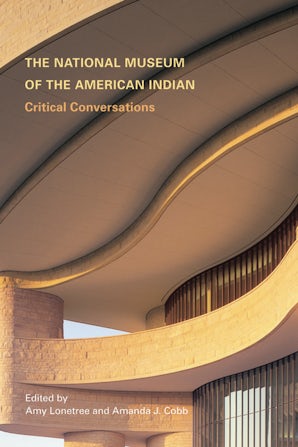
518 pages
21 photographs
November 2008
978-0-8032-1937-3
$29.95 Add to CartList of Figures
Acknowledgements
Dedication
Introduction
The National Museum of the American Indian: Critical Conversations
By Amy Lonetree and Amanda J. Cobb
Conversation One: History and Development
1. A New Thing?: The NMAI in Historical and Institutional Context
By Ira Jacknis
2. Decolonizing the Nation’s Attic: The NMAI and the Politics of Knowledge-Making in a National Space
By Patricia Pierce Erikson
3. Concourse and Periphery: Planning the NMAI
By Judith Ostrowitz
Conversation Two: Indigenous Methodology and Community Collaboration
4. Critical Reflections on the Our Peoples Exhibit: A Curator’s Perspective
By Paul Chaat Smith
5. Collaborative Exhibit Development at the Smithsonian’s National Museum of the American Indian
By Cynthia Chavez
6. The Making of ‘Who We Are’ Now Playing at the NMAI Lelawi Theater
By Beverly Singer
Conversation Three: Interpretations and Response
7. Gym Shoes, Maps, and Passports, Oh My!: Creating Community or Creating Chaos at the NMAI?
By Elizabeth Archuleta
8. “Indian Country” on the National Mall: The Mainstream Press vs. the NMAI
By Janet Berlo and Aldona Jonaitis
9. What Are Our Expectations Telling Us?: Encounters with the NMAI
By Gwyneira Isaac
10. No Sense of the Struggle: Creating a Context for Survivance at the NMAI
By Sonya Atalay
11. (Un)disturbing Exhibitions: Indigenous Historical Memory at the NMAI
By Myla Vicenti Carpio
12. “Acknowledging the Truth of History”: Missed Opportunities at the NMAI
By Amy Lonetree
Conversation Four: Questions of Nation and Identity
13. The NMAI as Cultural Sovereignty
By Amanda J. Cobb
14. Performing Reconciliation at the NMAI: Postcolonial Rapprochement and the Politics of Historical Closure
By Pauline Wakeham
15. “South of the Border” at the NMAI
By Robin Maria Delugan
16. Disrupting Past Paradigms: The NMAI and the Canadian Museum of Civilization
By Ruth B. Phillips
17. The NMAI and the Siting of Identity
By Mario Caro
Contributor Biographies